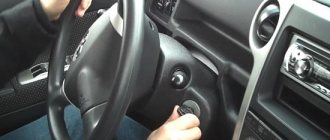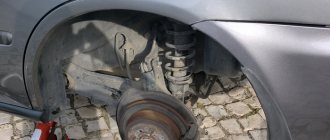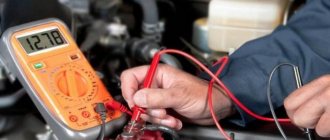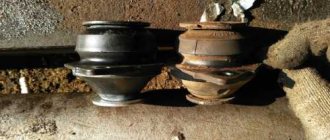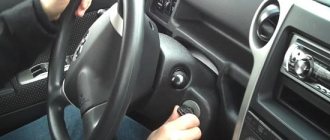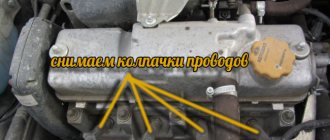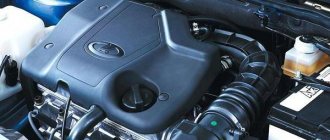Starter necessary for every car - this small device starts the engine, without which, for obvious reasons, movement is impossible. At the same time, the starter serves a rather short period of time, rarely exceeding six to seven years, after which it requires complete replacement with a new one as a result of wear. But even during six years of operation the starter is subject to minor breakdowns and malfunctions, which can be eliminated on your own.
Repair of starters with serious damage is best left to specialized car services, of which there are quite a large number today.
One of the symptoms of a starter malfunction may be a sharp, unpleasant sound during startup, which is similar to a mechanical grinding sound - there can be quite a few reasons for this phenomenon, but the main one is a malfunction of the starter gear .
During operation, the teeth of the starter gear wear out - scratches appear on them, they bend and gradually fail - of course, a gear with bent teeth cannot function normally.
Fixing such a malfunction is simple - you just need to disassemble the starter and, pulling out the gear, replace it with a new one. Bendix is one of the most inexpensive starter parts, but not replacing this part in a timely manner can hit your pocket hard. Quite often, due to gear wear, the Bendix cannot disengage from the flywheel, and the starter continues to work together with the engine until the device is completely destroyed. It will not be possible to straighten bent teeth using improvised means - a hammer or pliers, which every ordinary motorist has in their arsenal, so it is better not to try, but simply replace the bendix with a new one.
The next reason for the grinding noise may lie in the buffer spring - this is the most common reason why foreign car starters are repaired - the spring weakens its tension over time and the bendix does not come out completely, thus creating proper engagement with the car's flywheel. The only way out of this situation is its complete replacement, which can be done either independently or at a car service center. Work of this kind is not expensive.
The last reason for such a malfunction lies in the adjustment of the gear stroke itself, which can only be corrected in a car service center, with the help of qualified professionals with appropriate education and experience. In addition, incomplete bendix output can be caused by wear of the solenoid relay fork, and finding this part in retail is quite difficult.
You should always remember that if you are not confident that you can carry out high-quality repairs of a faulty part yourself, it is better not to undertake it. It is quite possible that you will only make things worse; the final repair may cost much more.
Engine grinding when starting is quite common, especially for older cars. But this malfunction did not bypass new vehicles either. The occurrence of this problem is associated with the failure of one or more elements in the motor.
Causes of malfunction
Before we begin to study the causes of the malfunction, we remind you that hereinafter we are talking about the crackling noise of the starter, which is most similar to the loud rattling of the contacts of an electromagnetic relay. If you hear an unpleasant metallic grinding noise from under the hood, then it appears due to poor engagement of the overrunning clutch (starter Bendix) with the flywheel teeth - that’s a completely different story.
Most often, the starter crackles when you turn the ignition key for three reasons:
Low battery
To understand the cause of the crackling noise due to a discharged battery, let's remember the starter device. When you turn the ignition key, the voltage from the on-board network is supplied to the coil of its solenoid relay. The electromagnetic forces that appear in this case cause the armature of the device to move. It closes the power contacts that connect the starter motor to the battery, and in addition, causes the Bendix gear to engage with the flywheel.
When the battery is discharged, its energy may be enough to attract the metal core - cranking the crankshaft is out of the question. As soon as the starter contacts close and power is supplied to its electric motor, the voltage drops to such an extent that the electromagnet is unable to hold the metal core. Under the action of the return spring, it tends to take its original position and opens the power contacts. The restored voltage contributes to the repeated retraction of the anchor, and the situation is recreated many times.
To make sure that the culprit of the problem is a deep discharge of the battery, just turn on several consumers (lighting, electric heater motor, etc.) and press the sound signal. The latter will either not turn on at all, or will be heard with wheezing, reduced amplitude or attenuation.
Poor engine ground contact
The picture of what is happening is practically indistinguishable from the case discussed above, with the only difference that the test for battery discharge ends with a negative result - all consumers, including the sound signal, are working at full strength.
At the same time, it is very simple to determine that the cause of the malfunction is poor contact between the battery and the engine - just pay attention to the oil pressure warning lamp, which is located on the instrument panel. If the voltage in the car’s on-board network is below normal, then turning the ignition switch to the “Start” position will lead to a gradual attenuation of the brightness of the warning lamp (like all others).
In the case where the cause of the crackling sound of the starter solenoid relay is a bad ground, an attempt to start the engine will lead to its complete extinction in time with the clicks of the solenoid relay. At the same time, other indicators practically do not change the intensity of the glow.
Everything is explained very simply - the “mass” of the oil pressure sensor, as well as the starter, is the housing. Therefore, as soon as the electrical contact between the engine and the battery is lost, both of these devices stop working synchronously.
Open or shorted starter relay winding
Another reason why the solenoid relay cracks is an interturn short circuit or a break in its holding winding. In other words, the efforts of the electromagnet become insufficient to keep the power contacts of the starter relay in the closed state and engage the overrunning clutch gear with the flywheel ring gear. Under the action of the return spring, the bendix tends to take its original position, and the contact pad located on the armature opens the electrical connection. After this, the retractor winding turns on again and the situation repeats itself many times, which causes the crackling noise.
to determine that in this case the starter solenoid relay has failed by the behavior of the warning lamps located on the instrument panel. At the moment when the loud clicks of the starter are heard, their brightness does not change - the switching of the starter motor occurs for such a short time that the battery voltage practically does not drop.
Something else useful for you:
- The starter does not turn the retractor, but clicks
- How to check the starter solenoid relay?
- Why doesn't the car start, but the starter turns?
Causes
Why is there a crackling and grinding sound when starting the engine? This question is often asked by beginners and not-so-motorists. Many people are frightened by the strange sound heard when starting the engine. Although in many cases this is not a difficult problem. But it still needs to be eliminated, and for this it’s good to know where to look for the problem. There are several places that produce crackling and grinding noises during startup:
- Starter;
- Flywheel;
- Roller mounting bolt (timing).
Knowing the main places of breakdowns, you will quickly find out where the main problem is. For a more accurate diagnosis, open the hood and ask someone to start the engine. If there are problems with the starter and flywheel, a cracking noise will be heard from the rear of the engine when the bolt is unscrewed at the front.
Why does a crackling sound appear on a cold engine?
When the internal combustion engine is idle, oil flows into the crankcase, and thermal clearances in the mating parts at low temperatures are outside the standard values. In the first seconds after starting, the engine experiences increased loads, so a cracking sound in the engine usually occurs when it is cold.
A common culprit for sounds are timing gear drive parts:
Checking the timing chain for tension
- stretched timing chain;
- worn crankshaft and camshaft pulley gears;
- chain tensioner or damper;
- timing belt tension roller;
- faulty hydraulic compensators, incorrectly selected washers and other parts for adjusting valve clearances;
- the camshaft makes a cracking sound when cold after starting the engine if there is wear in its beds;
- camshaft pulley with a faulty control mechanism in engines with variable valve timing (VVT, VTEC, VVT-I, Valvetronic, VANOS and other similar systems).
The source of crackling and grinding noises when cold can also be parts of attachments:
Worn generator bearing
- worn or unlubricated generator bearings;
- damaged power steering pump and air conditioning compressor;
- cooling system pump bearing;
- starter bendix with critical wear;
- The exhaust manifold protection, which resonates with the vibration of the engine, can produce crackling and metallic clicks when cold.
The problem is less likely to lie in the engine itself, but with high mileage, untimely and poor-quality maintenance, the following can crack when cold:
Worn main bearings
- piston skirts knocking on the cylinders due to increased clearances;
- piston pins - for the same reason;
- worn main connecting rod bearings.
In addition to the engine, the transmission sometimes becomes the source of crackling noise when cold:
- a driven clutch disc in which the damper springs have sagged or there is wear in their windows;
- worn gearbox input shaft bearings;
- gear bearings on the secondary shaft of the gearbox;
- insufficient oil pressure in the gearbox.
Even if a crackling sound is heard only when starting the engine when it is cold, and goes away after warming up, you need to make sure there are no malfunctions. Otherwise, the wear of parts will progress until the incorrectly functioning unit fails . The instructions and tables below will help you carry out the diagnosis.
In some models, in particular VAZ with 8-valve engines with manual adjustment of valve clearances, a distinct clatter of the camshaft in cold weather, which disappears after warming up, is a design feature and is not considered a malfunction.
Why is there a crackling and grinding sound when starting the engine? Most likely it's the starter
Drivers are often interested in why crackling and grinding noises are heard when starting the engine. There may be several reasons for this phenomenon. In any case, the source of this sound should be eliminated as quickly as possible. Otherwise, you risk a breakdown at the most inopportune moment. In general, if any strange sounds appear, you should check their origin. After all, this is most likely a sign of a breakdown.
The sooner you eliminate it, the better. After all, most faults can cause a chain reaction. And provoke breakdowns of other engine components. Therefore, always listen carefully to the operation of the power unit.
Conclusion
Grinding and crackling noises in the power unit indicate that some engine parts have failed. So, the grinding noise is accompanied by a malfunction in the starter or flywheel. As for the crackling sound, the situation is much more complicated - most likely the problem is hidden in the crank mechanism or in the cylinder head.
If such malfunctions occur, it is recommended to contact a car service as soon as possible, so as not to cause more trouble than already exists.
Even an inexperienced car enthusiast will say that the main unit in any vehicle is the internal combustion engine. If a malfunction occurs in the operation of this unit, the driver will know about it immediately by the behavior of the car. One of the common problems in engine operation is the appearance of extraneous sounds. Why a whistle is heard when starting the engine and what to do in this case - this material will help you understand the problem in detail.
Causes of extraneous sounds in the engine compartment during or immediately after starting the engine
Worn generator bearings
If you hear a whistle and other extraneous sounds when starting the engine, this may indicate various problems associated with its operation. As a rule, these sounds are not so much dangerous for the unit as they are annoying to the driver himself. However, if squeaking, clicking, or knocking noises from the engine occur, the problem must be addressed immediately.
Belts
So, if a whistle appears when starting the engine, then one of the most common causes of this problem is belts. The squealing noise may be due to wear on a particular belt or poor tension, and it may become louder as the crankshaft speed increases. But sometimes when you press the gas, the whistle may disappear altogether. If you hear a whistle when trying to start the engine, then first of all you need to check the tension of all drive belts.
If during the diagnostics you notice that one of the belts is loose, this in turn can lead to its slipping, which can lead to the appearance of sounds uncharacteristic of engine operation. In this case, tightening the strap can solve the problem. Remember that slipping can also be caused by dirt and engine fluid that gets on the straps. If this is the case, then the cause of the oil leak must be solved before replacing the belt; of course, you can try to clean it, but experts recommend changing them anyway (the author of the video is the channel In Sandro’s Garage).
As practice shows, most often ringing and squeaking when starting the engine is caused by the alternator belt, and extraneous sounds disappear after increasing the engine speed. This problem is fraught with insufficient battery charge, which, in turn, can lead to multiple consequences. Moreover, if the belt breaks, the battery simply will not be able to charge while the engine is running. As a result, a corresponding low battery indicator may appear on the dashboard; if this happens, you need to check the condition of the belt itself.
In some cases, the problem may be with the timing belt, and the consequences of such a malfunction will be more serious. The appearance of extraneous sounds may be due to wear of the bearings. If the strap itself breaks for some reason, this can cause the valves to bend, and such repairs, in turn, require large financial costs. Check the condition of the belt itself - there should be no signs of damage, peeling or cracks. If they are present, the strap must be replaced.
Rollers and bearings
The appearance of unpleasant rattles, pops and other third-party noises can occur due to the fault of bearing devices, as well as rollers. The engine design uses more than one bearing and roller, so it can be difficult to find the cause. From a normal whistle, the sound when rollers and bearings wear out will be lower; as a rule, it appears when the engine is running at idle speed. Moreover, when they increase, it will either disappear completely or be quieter. Worn rollers with bearings must be replaced before a more serious problem occurs (video author - IB Channel).
Intake system malfunctions
Grinding and popping noises, as well as crackling noises when starting the engine, sometimes occur due to malfunctions in the operation of the intake system. Of course, you should move on to this option when you are sure that the bearings, rollers and belts are working properly.
So, what malfunctions are typical for the intake system:
- Throttle valve. This unit sometimes jams, as a result of which it creates specific turbulence in the air flow. If the appearance of grinding and popping noises, as well as whistling, is caused by this particular problem, the damper must be completely flushed. Please note that to most effectively clean the unit, it will need to be completely dismantled.
- The reason may also be the intake valve, which is responsible for the circulation of crankcase gases. If it becomes clogged, it will prevent normal circulation of hot air; therefore, due to very high pressure, engine fluid may be squeezed out of the seals. To get rid of such a malfunction, the valve will need to be cleaned, but to do this it must first be removed. Depending on the design features of the engine, it can be located either on the crankcase ventilation pipe or on the valve cover. If the valve itself is made of metal, any substances that will not scratch the surface can be used for cleaning. If the device is made of plastic, then it is better not to use aggressive agents.
Turbine malfunctions
Most modern cars are equipped with turbochargers, the purpose of which is to increase engine power, as well as improve the driving characteristics of the car as a whole. However, it is another powertrain component that can cause knocking, grinding, and popping noises. If the engine starts and a knocking and grinding noise is heard, then there is a possibility that this problem is caused by an air leak in the place where the turbocharger and the power unit connect. As a rule, the appearance of sounds uncharacteristic of internal combustion engine operation indicates a failure of the turbocharger. This malfunction is more typical for diesel units (the author of the video is the MZTk Turbocom channel).
Starter
If you clearly hear a grinding noise, then there can only be one cause of the malfunction - the bendix, which is one of the main elements of the starter, for some reason cannot engage with the flywheel. The grinding noise itself appears as a result of skipping teeth. It should be noted that such a breakdown must be eliminated as quickly as possible, otherwise there is a possibility of damage to the gears of both the flywheel and the starter unit.
The following elements are subject to diagnosis:
- First of all, you should diagnose the mounting of the device - in practice, due to driving on uneven roads, the bolts that secure it may become unscrewed. This leads to the fact that the mechanism will be skewed, accordingly, the gear will lose contact with the flywheel. You need to dismantle the starter assembly and diagnose the condition of the bendix.
- If the problem lies in gear wear, then the efficiency of the mechanism will be significantly reduced. The grinding noise itself will appear as a result of the bendix bypassing, and if you do not deal with this problem as quickly as possible, the starter device may eventually stop turning the flywheel altogether. After dismantling, if the gear is really worn out, you will be able to see it without the help of specialists.
- There is a possibility that the bendix does not move well along the shaft and is not able to reach the flywheel. Try to dismantle it, and lubricate the shaft itself with engine fluid, then reinstall it and re-check the operation of the unit. It would not be superfluous to carry out diagnostics of the traction relay.
1. New and worn gear
2. Worn out bendix
A grinding noise is heard when starting the engine
If the driver turns the ignition key to the “start” position and at this moment a grinding noise is heard, and the noise disappears after the engine “cages” and starts working on its own, then the most common cause is considered to be a faulty starter.
If, when starting the engine, you hear the starter grinding whether it is cold or hot, then there may be several reasons for such a malfunction.
We also recommend reading the article about why the starter does not work after turning the ignition key. From this article you will learn about the main reasons that lead to the starter not working, failures during startup, or the appearance of extraneous sounds when starting the internal combustion engine.
As a rule, it is necessary to check the solenoid relay, starter bendix and flywheel. The fact is that the bendix may not engage with the flywheel properly, resulting in a crackling sound or a characteristic starter grinding sound when starting the engine.
Diagnostic and troubleshooting methods
Many car enthusiasts, leaving home in the morning and starting the vehicle engine, have encountered a grinding and crackling sound when starting up. In this case, the malfunctions are different and it is worth understanding what sound means what.
Starter, flywheel and solenoid relay
Perhaps it’s worth starting our consideration with the fact that a grinding noise appears during the start-up of the power unit. As it was found out earlier, the issue here is in the starter or flywheel. So, if the grinding noise continues until the engine starts, this is due to wear on the bendix or flywheel crown.
To be more precise, the teeth of one or the second element are worn out, and the part does not adhere well to the part. Also, the issue may be in the solenoid relay, which does not fully pull the bendix, which does not grab the flywheel.
To eliminate the malfunction, it is necessary to dismantle the starter and inspect the condition of the bendix, namely its teeth. If there is characteristic wear in the form of “licking” of the teeth, then it is recommended to replace the part. But that's not all. Also, since the starter has already been removed from the vehicle, it is worth checking the solenoid relay.
To do this, you just need to connect it to the on-board 12 volt network and listen to see if the solenoid relay clicks. If clicks are not heard, then you will have to disassemble the starter and replace the failed part.
Also, this malfunction and the grinding effect can be caused by the fact that the flywheel crown is worn out. It is worth noting that not all engines have a dismountable flywheel, so the entire assembly part is often replaced. Thus, the wear of the teeth leads to the fact that the Bendix cannot catch on them and turn the crankshaft. It is at this moment that a grinding noise occurs in the engine compartment.
Cracking - where to run and what to do
A cracking sound is a malfunction in the crank mechanism or cylinder head. So, first of all, it’s worth checking the cylinder head. Malfunctions must be looked for in the guide bushings, where wear may have occurred and the valve simply dangles, and hydraulic compensators can also knock and crack, which should be replaced because they have exhausted their service life.
The second place to pay attention is the cylinder block and its elements. So, a cracking noise can be caused by a lack of lubrication (engine oil), as a result of which the oil scraper rings scratch the cylinder walls. Also, special attention should be paid to the main and connecting rod bearings, which can rotate due to wear on the part of the block itself.
In this case, special attention should be paid to the condition of the crankshaft, which could have scratches and deep grooves.
The last element that can also cause cracking and damage the cylinder walls is the connecting rod bushings. They could become loose and go beyond the pressing limits. In this case, the danger is that the bushings can damage the cylinder walls so much that the only solution is to line the block or replace it.
Starter
{banner_content}There are several reasons for this behavior. In order to understand the reasons in more detail, you need to know the starter design and operating principle. It consists of an electric motor, on the shaft of which an overrunning clutch with a drive gear is installed. In everyday life, the clutch and gear are called bendix. The design also includes a starting relay with a solenoid. This design is called a “traction relay”. It is connected to the clutch by the starter activation lever.
This design works as follows
. When turned on, the electric motor begins to rotate the bendix. At the same time, the traction relay, having activated, moves the overrunning clutch forward using a lever.
As a result, the gear meshes with the teeth of the flywheel and spins the engine. After the engine starts, the overrunning clutch is activated. This protects the starter from damage. When the power supply to the device is turned off, the relay stops working and
Bendix starter
returns to its original position. Passenger car starters usually use a roller-type overrunning clutch.
There is only one reason for the grinding noise at startup. For some reason the Bendix cannot fully engage the flywheel. Therefore, when starting the starter, a grinding sound of skipping teeth occurs. This problem needs to be fixed as quickly as possible. Otherwise, the flywheel and starter gears may be damaged. You need to check the following points:
- First, check the starter mounting. Sometimes vibration can cause the mounting bolts to come loose. In this case, the starter becomes warped and the gear loses full contact with the flywheel. In any case, remove the starter and check the condition of the bendix;
- Sometimes the problem can be caused by gear wear. In this case, the starter's performance decreases. When starting the engine, you will hear the grinding sound of the bendix moving around. Over time, the starter will not be able to turn the flywheel at all. After removing the part from the machine, you can see the gear wear with the naked eye;
- Sometimes the Bendix does not move well along the shaft and simply does not reach the flywheel. In this case, remove it. You need to coat the shaft with any motor oil (5w30 or 5w40 or whatever you have on hand). Also check the operation of the traction relay.
These are the main causes of a grinding noise at startup associated with this particular part. Most often you will find
there is a problem somewhere in the starter
.
A crackling sound when starting can also occur due to problems with the starter's power supply. It appears when the positive wire is loosened. If there is poor contact, a spark discharge occurs, which is what produces a crackling sound. Check the wire. Tighten it if necessary.
Flywheel
. The cause of the grinding noise may be in the engine. If the flywheel teeth are worn too much, they cannot form full contact with the starter gear. As a result, you can hear an unpleasant grinding noise. It is advisable to replace the flywheel. Otherwise, wear on the bendix will increase and you will have to change it regularly.
Since we're talking about the flywheel, read our two materials on this topic:
- “Pros and cons of a lightweight flywheel”;
- “Independent replacement of a dual-mass flywheel with a single-mass one.”
Roller mounting bolt (timing)
. Sometimes the timing drive pulley may come loose. At the very beginning of this process, a grinding noise is observed immediately after the engine starts. After warming up everything goes away. It is recommended to tighten the bolt properly. This problem often occurs on the tenth VAZ family.
Conclusion
. A faulty motor can make a variety of sounds. Therefore, it is important to know the main causes of these phenomena. At the same time, drivers are often frightened by the simplest things and ask why crackling and grinding noises are heard when starting the engine. The answer to this question is quite simple. In most cases, the cause of these unpleasant sounds is the starter, or rather its elements.
Starter malfunction
If, when starting the engine, the starter makes one loud click and nothing else happens, in 100% of cases this is caused by problems in the module itself. One click indicates that charge is reaching the starter as the relay clicks. In this case, failure of the relay is excluded. The cause of the problem with the functioning of this module may be an unstable charge that reaches it. In this case, you should try to start the engine again, and repeat attempts at intervals of 20 seconds. Perhaps on the 2nd or 3rd try you will be able to start the car. If the engine still does not start, investigate the following potential causes of the problem:
- the starter bendix has failed;
- the retractor is broken;
- the main winding of the starter is broken;
- winding short circuit;
- brushes and bushings are worn out.
We recommend: What to check before buying a car
In the latter case, it is only necessary to replace the failed components.
In any case, regardless of the reason why this problem occurred, the first step is to inspect and check all contacts visible from the outside. Often the starter stops performing its functions normally due to weak contact in one or another node. An unstable charge is also a fairly common cause. In this case, you just need to repeat the attempt to start the engine several times. Most likely, after two or three attempts you will be able to start the engine, and a similar situation will not repeat during subsequent starts.
Even if you eventually managed to start the engine after some attempt, you should not consider the problem solved. Otherwise, at some point the car will simply stop starting and you will have to look for alternative ways to start the engine. You should not solve the problem by replacing the starter.
A car has long ceased to be a luxury. It’s hard to imagine life without a car these days. Many people drive a car every day and for any need - to work, study, dacha, shopping, on vacation. And that's why it becomes very bad when the car won't start. Plans are ruined, meetings are cancelled, people lose money!
We will look at situations where the starter works, but the car still does not start, another time. And now - about what to do if the starter on a Priora does not turn.
First, let's understand how a starter works and what its structure is. An electric motor with a gear that meshes with the engine flywheel and turns it when started. All this is hidden in a housing on which the solenoid relay is mounted. It is designed to move the gear and supply power to the electric motor.
When you turn the ignition key, current is supplied to the relay. Using an electromagnet, it is retracted, using a special mechanism, it moves the gear and starts the engine by closing the contacts. When the key is released, power stops being supplied to the magnet of the solenoid relay, the relay operates in the other direction and the contacts open. So, we know what the principle of operation of the starter looks like in general terms, so now it will be easier for us to understand why the starter does not turn on the Priora.
If you hear clicking sounds when you turn the ignition key and the lights on the instrument panel go out, it may be the battery. It needs to be checked, recharged, topped up with electrolyte or replaced. Is the battery OK? Then the situation becomes more interesting. Check the wires that come from the battery. If they get hot, check their contact with the battery. Remove them from the terminals, clean them, lubricate them (sometimes oxidation occurs) and install them back.
Check the connection between the ground terminal and the body. If necessary, clean this connection. Check the connection between the plus terminal and the starter. Determine if power is supplied to the solenoid relay from the ignition switch. To do this, you need to disconnect the connector from the relay, and turn the ignition key “to start” and measure the voltage at the connector.
The Priora starter still won't turn? Then you will have to remove it from the car and check it.
The removal procedure looks like this: disconnect the battery terminals, unscrew and remove the air filter, unscrew and remove the positive wire from the starter. Then disconnect the connector from the relay, unscrew the starter mounting nuts and remove it. We are already much closer to solving the question of why the Priora’s starter does not turn. Now we take the wires for lighting (crocodiles) and connect them with the negative wire of the battery and the starter housing. We connect the positive one to the relay connector, after which the gear should be activated and ejected forward. If not, change the retractor.
You can hook the negative wire to the starter housing, and the positive wire to the lower terminal of the solenoid relay. The electric motor didn't work? The culprit is most likely the motor brushes.
Diagnostics
The first step is to determine the source of the sound. You can do this yourself, but in this case you need to clearly know the characteristic sounds of each mechanism. The easiest way is to ask a friend to start the car, and listen and determine the source yourself.
In 99% of cases, the malfunction lies in such elements of the engine compartment as:
3) Power steering.,
Bearings creaking
Typically, various bearings run for 100 thousand kilometers or more. However, over time, the lubricant inside them runs out and the elements begin to rub, making a creaking noise. These bearings don't last long. In winter, this worsens due to the loss of lubricating properties of the filler.
Whistling belts
Whistling belts are the most common cause of all of the above. This occurs due to their wear and tear, as well as temperature changes. Some spare parts manufacturers make drive belts from low-quality rubber, which quickly hardens in the cold.
Power steering
If it whistles for 3-4 seconds and then stops, this is normal. In the cold, the technical fluid also loses its fluidity, so for some time the pump operates with overload. However, if the power steering does break down, you should not do it yourself, as it is a very complex mechanism.
Starter
Most often, a grinding noise (precisely a grinding sound) occurs when the engine starts. In 99% of cases this is a bendix malfunction. The repair is very simple - you need to remove the starter and lubricate this same bendix. You should not delay this - over time it may fail.
Source
There is a knocking sound when starting the engine
The appearance of knocking in the engine should be divided into problems with the gas distribution mechanism and the elements of the internal combustion engine itself (crankshaft and CPG, pistons, connecting rods, crankshaft, etc.). Extraneous sounds in the timing area may indicate significant wear of the rollers, defects in the timing belt or chain.
The rollers may whistle, howl, crunch or tap. In some cases, the timing belt rubs against the protective casing. We also note that on motors with a chain, when the chain itself is stretched or the tension is insufficient, the sound resembles a rustling chirping, and popping noises can also be heard. If you increase the speed, such sounds disappear and appear again after releasing the gas. In this situation, the timing chain needs to be tightened or replaced.
A characteristic knock of the gas distribution mechanism is the knock of the intake and/or exhaust valves. This knock differs in frequency from other knocks and has regular intervals. The fact is that the camshaft rotates twice as slow as the crankshaft. Improper adjustment of the thermal clearance of the valves can cause knocking noises.
On engines with hydraulic compensators, a common cause is failure of the latter or clogging of the oil supply channel to the hydraulic compensator. In this case, the sound is clear, clear, and can be easily heard in the valve cover area. Note that on many cars, after a cold start, the hydraulic compensators knock for several seconds until the engine oil reaches them. This is considered the norm. If the knocking does not go away after the engine warms up, then you need to contact a service center or solve the problem yourself.
Now about knocking in the engine itself. After starting a cold unit, you can hear the pistons knocking in the cylinders. The knock is dull, similar to hitting pottery. The knocking of the pistons is most pronounced at idle, as well as at low speeds under load.
Also, the engine may experience a knocking sound from the main or connecting rod bearings of the crankshaft (crankshaft plain bearings). This knock has a metallic tint and is slightly muffled. As a rule, at the initial stage, the malfunction appears after starting the engine if you sharply press the gas in idle mode.
The frequency of the knocking increases parallel to the increase in speed. Axial play of the crankshaft also leads to knocking sounds, while the sound is sharper and differs in that the intervals between knocks are uneven. It can be heard most clearly when the crankshaft speed changes smoothly.
When it comes to connecting rod knocking, a common cause is a problem with the connecting rod bearings. This knocking sound is sharp and can be clearly heard when you press the gas pedal sharply. During diagnostics, a knocking piston or connecting rod can be determined by turning off the spark plug on each cylinder one by one.
